Nowadays, with the Golf range updated, the sporty models are the GTI, GTI Performance, GTE and R. The GTD will be left out because it has become an ugly duckling in the brand, despite the fact that the TDI engines now fitted in the Golf are among the cleanest on the market (and I'm not saying that, it's just data). Also, in terms of power it's under 200 hp, but it's a pretty rational model if I may say so.
We took advantage of our visit to the Race Tour at the Jarama to drive the Golf GTE, GTI Performance and R
As the Volkswagen Golf is the best-selling compact in Europe, economies of scale make it profitable to sell a few units of the higher performance models. If it weren't for the number of mid-range TSI and TDI models sold, this type of model would be difficult to justify. Not only take advantage of the synergies of the range, but the Group's own, as the engine of the Golf R is the same as that of the Audi S3, for example.
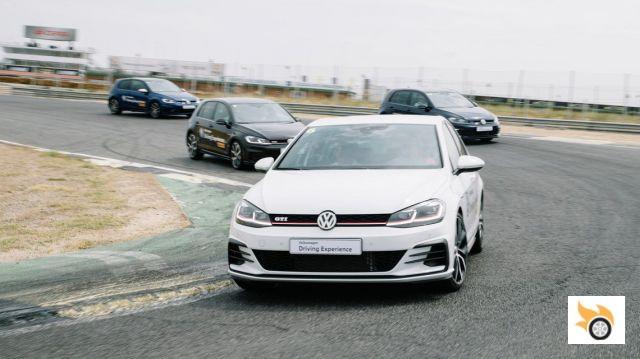
The sporty offer can be considered initiated by the Golf GTE, the plug-in hybrid. From a 1.4 TSI petrol engine of 150 hp we get 204 hp combined with an electric motor and a generous battery that allows 50 kilometers without exhaust fumes. In 100% electric mode it has a more than reasonable 102 hp, which is more than enough for everyday use. The gearbox is automatic, a six-speed DSG.
In hybrid mode yes, we have 204 hp, as long as the battery charge level allows it, but there will not be many occasions in which we suffer a temporary limitation of performance. In principle we can entrust the car the task of keeping the batteries at a level of charge with sufficient reserve to enjoy that power beyond 50 kilometers of range. If you need to drive without petrol at a later date, you can charge the batteries "at full throttle", making the 1.4 TSI use more fuel.
But let's get back to the point. The Jarama Circuit is huge for a car with 102 hp, but the test started like this, in electric mode. There wasn't a big difference compared to an e-Golf (100% electric) that I had tasted minutes before in the paddock area. Acceleration is very similar. The good thing about the GTE is that it allows you to travel wherever you want, the e-Golf doesn't allow that at the moment.
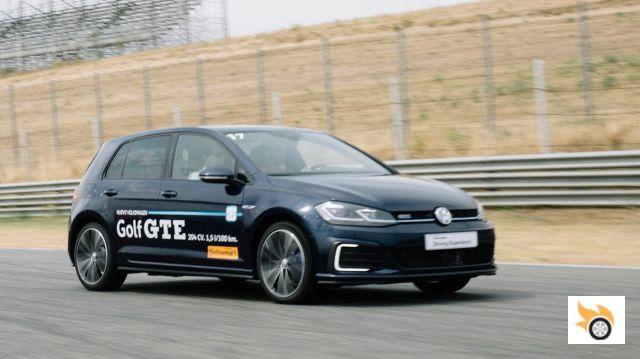
If we activate the GTE mode we notice a difference in the car's character, which amplifies the sound of the petrol engine through the speakers. I must say that, having tried several artificial sound synthesizers, I found this one as convincing as a membrane, i.e. a mechanical sound transmission. It will only disappoint someone looking at the car from the outside, but inside, the car convinces.
I couldn't appreciate the car's behaviour at the limit because the instructor who accompanied me didn't even allow me to take advantage of 80% of its possibilities, but it's certainly not just another plug-in hybrid. The isolation is very good, it doesn't feel too heavy (1,615 kg) and we were four adults on board. I like the concept, the best of an electric and a thermal at the same time, almost with the character of a GTI, even share tire size. The downside? You have to fork out more than 40,000 euros to have all that at the same time.
The next step up is the Golf GTI, which now starts at 230 hp, the same as the Golf GTI Performance before the restyling of the seventh generation. Of all the models reviewed it has the lowest starting price, 36,000 and some for the five-door DSG, extras aside. Its performance is not excessive for a front-wheel drive, it's relatively well controlled, at least on dry and good tarmac.
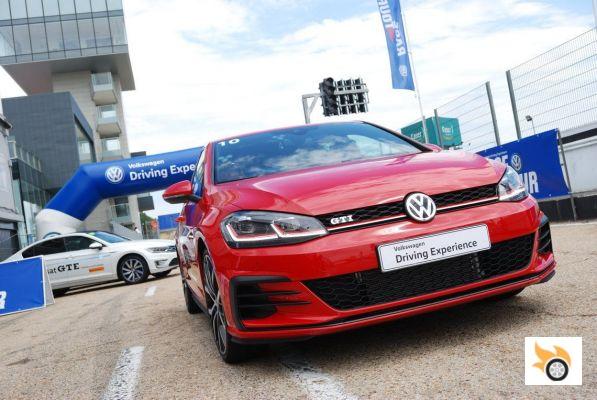
This model wasn't available for testing, but the GTI Performance was, which ups the ante to 245bhp. Not only does it run more, it has a real front self-locking differential, more powerful brakes (340 mm at the front with red calipers) and a bit more equipment like 18″ wheels instead of 17″. We're talking about 2,100 euros more and the difference in performance is really small, a couple of tenths of acceleration. In the case of the automatic, the DSG has seven speeds instead of six.
The brief time I drove the GTI Performance I found it very convincing in terms of cornering and ability to transmit power to the ground, which 245 isn't exactly low horsepower. The GTI plows 350 Nm to the front end between 1,500 and 4,600 RPM, while the GTI Performance throws out 370 Nm between 1,600 and 4,300 RPM. The steering is very precise, there's no mid-trajectory correction, and understeer hints are predictable and easy to correct if you have a minimum margin of safety.
For a Golf GTI to suffer a lot of understeer, it has to be deliberately mis-steered. Before the end of the test day there was an exercise in driving on a Mickey Mouse circuit (very tight corners that are taken in first gear), where it is vital to control the throttle and steering in order not to lose time or traction. To drive a front-wheel drive car in these circumstances has its science, at a certain point to step on the accelerator more does not mean more speed, but the opposite: the aids will intervene more and it will stay stuck.
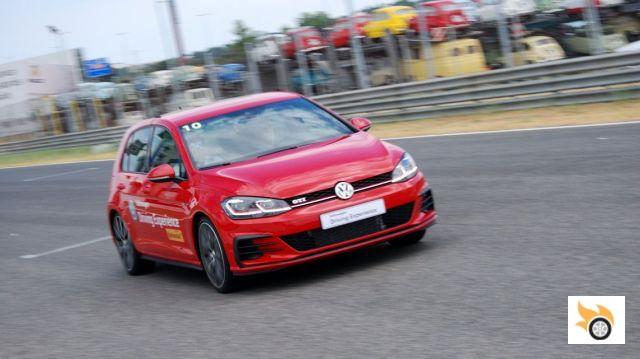
With the GTI Performance I only drove one lap, the explanation will come later. I felt very comfortable driving it, other front wheel drive cars I've driven fast on the track have been disappointing because of their constant loss of traction. Let's just say my pace was below 90% of what the car is capable of. Now, is it worth paying almost 2,000 euros more over the GTI? I'd have to take one after the other, but a priori I don't think so, except for the self-locking system.
Then comes the main course, the Golf R. Unlike the GT-something, the R has all-wheel drive with the well-known Haldex multi-clutch system that transfers power to the rear axle when the front axle slips. Plus, we're talking about 310bhp of power from a 2.0 TSI, the same as the GTI, but this one is tight. It barely delivers more torque than the GTI Performance, 380 Nm, but it holds them in a more interesting regime, from 2,000 to 5,400 RPM. Peak power lasts for 1,000 RPM compared to 1,700 RPM for the GTI Performance. It's fuller at low and medium revs, to put it another way, and at high revs it's still imposing in terms of brute force.
I actually drove the Golf R before the GTI Performance. It was two laps. In the first one I tried to go as fast as possible, taking advantage of the full width of the circuit, almost to the point of rushing the kerbs. Previously the instructor had done a fire lap in which he went up in the kerbs very well, very spectacular, seeing the G-force meter above 1 in more than one corner. The car held up with great aplomb, I must say.
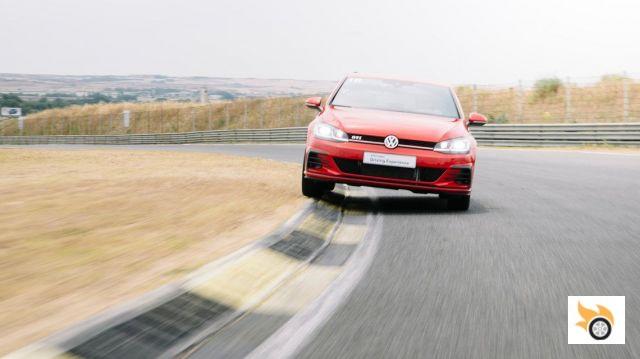
In my case the driving was more oriented to carry semislick tires, which are optional on this model and that the tested unit did not have. I was wearing Continental SportContact 6, less radical and more usable. I could have closed more the trajectories towards the apex (go more on the inside), something that the instructor reproached me in the first straight. The next one I was finer and went more inwards, the car holds it without understeer beyond the obvious.
The Golf R allows you to go very fast, on rails, a less powerful propulsion is more fun.
Obviously you notice a difference in power from 245 to 310 hp, the boosted engine feels fuller and with a more atmospheric V6 character: it's more predictable what it's going to push. The 2.0 TSI with 245 hp is somewhat less predictable and can occasionally run out of steam if we are not in the right gear ratio or have blindly trusted the S mode of the DSG gearbox. It's better to use the paddles, the engine is better used. In the Golf R I found the gearbox more predictive, we connected better.
The Golf R has oversized brakes, runs more and weighs more, 1,505 kg, reasonable for a compact 4×4. Optionally you can have an exhaust system, also quad-outlet, signed by Akrapovič. The exhaust, which is an option of more than 3,000 euros, improves the sound significantly and saves 7 kg. The unit tested had the stock exhaust. It sounds fat, but it doesn't sound too much either, perfectly bearable for those who want to drive a sleeper (very powerful car that goes unnoticed easily). Another interesting extra is some brakes more resistant to the beatings of the circuit and that relieve a couple of kilos the unsprung masses.
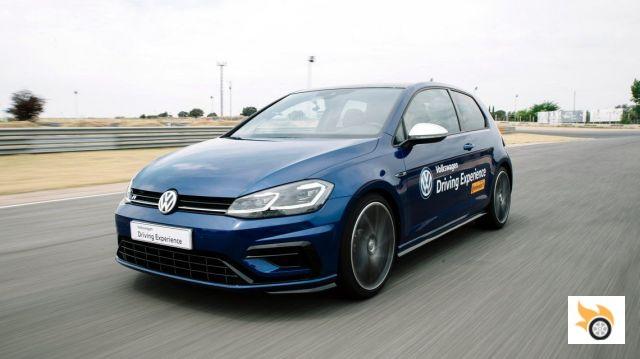
At the end of the second lap it's time to start cooling and get to the pits calmly so that the brakes don't arrive burning. More than 400 degrees were measured when the car stopped. It is a car that allows to go very fast with great ease, it is not an uncontrolled crazy goat. I'm sure the extra power would have been more noticeable in the wet, but in the dry... the GTI Performance can really do battle with the Golf R in the right hands.
I'm sure the instructor with the GTI Performance would have beaten me by a few seconds with the R. But if I'd been wearing the semi-slick, I'm not so sure he'd have left me far behind on road tyres. I'll be left with the doubt, because I don't think we'll be sharing a car again.
The second lap of the GTI Performance didn't allow me to do it, when I was going down the straight to the finish line, he sent me straight to the pits. I was already warned that the brakes were at 30% of life and I was not going on fire, in fact I went fast through Jarama with brakes at the limit of their useful life. I reviewed the video with telemetry in my possession and I didn't see anything wrong with my driving. When we stopped, without having explained to me why I had done a lap less, he stopped the engine and got off. I must understand that he was annoyed.
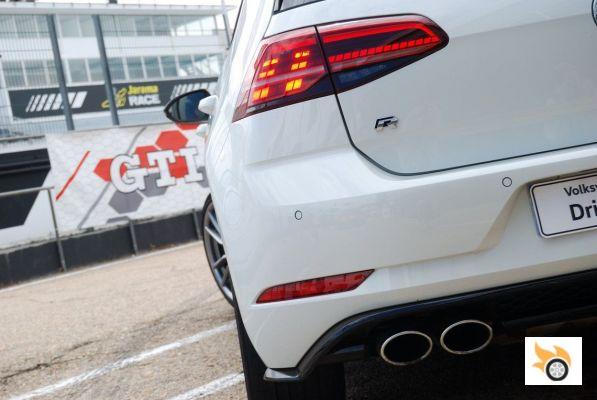
Anyway, dear friends, I'm weeks away from 10 years driving around Jarama with cars of very different conditions, and I've only had two scares. One was in a Boxster Cup when I was 24 years old trying to go flat out, but I lost control in Bugatti without any consequences beyond a stall. The second was when I stepped on the accelerator in a corner with a rear car that I had deactivated the assists. I had room to brake and nothing happened. It's an occupational hazard.
My duty as a motoring journalist is to see how the car is doing when going fast, not to go at the pace of a customer invited by Volkswagen and think I'm Toretto for reaching 190 km/h on the main straight. However, I put myself in the instructor's shoes, he doesn't know me, and I was driving a bit faster than he thought was prudent. I went a lot faster with other cars and nothing happened, my best time will be slightly under 2 seconds. I don't want to fool anyone, I'm not a driver, I go as fast as I can, as fast as the car can, and as fast as I dare: never 100%.
Let's get back to what we're talking about. Is it worth paying almost 44,000 euros for the Golf R? Yes. The prices I'm taking into account are all things being equal, all five-door and DSG. Yes, it's a lot of money, but apart from the Nissan 370Z, which is abnormally cheap, there's no shortage of cars with 300bhp or more at that price level in the Spanish market.
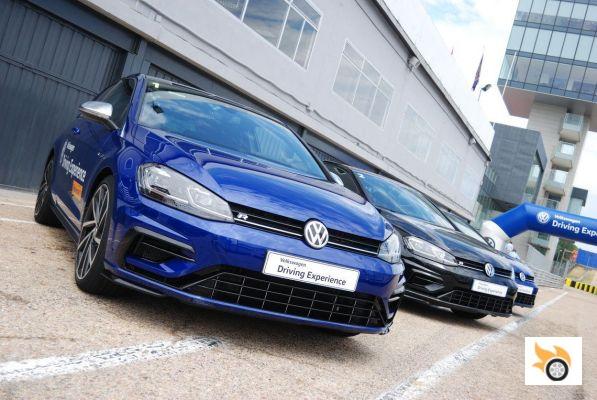
The Volkswagen Golf R is priced very close to the Honda Civic Type R (320 hp FWD), the SEAT Leon 4Drive Cupra (300 hp AWD), Ford Focus RS (350 hp AWD) and Mustang 2.3 EcoBoost (317 hp RWD). Is it expensive? I'd say it's in line with the others, with the usual price premium you'd expect in a Golf. It's not exorbitant. Except for the 370Z, all the models I mentioned are turbocharged four-cylinders. My mate Guille was convinced by the full package in the pre-styling model, I'm convinced too, but I think for most people the GTI, without Performance, is already a car that goes a long way as it is.
If we get out of the circuits, even more, to notice important differences between the GTI, the GTI Performance and the R, we are talking about the typical driving that the helicopter drivers see and we go on the news as the most reckless driver in Spain. Sports Golfs are more than just cars for speeders. The GTI, GTI Performance and R do not exceed 250 km / h, who wants to run more will have to ask the R deslimitation and stand at almost 270 km / h, but the difference matters little if from 200 km / h you can release criminal records. Outside Germany I don't see much sense in that option.
With the Golf R I didn't reach 200 km/h on the Jarama straight. With that I want to say it all. Let's go over the differences between the models analysed in a very brief table. Whether one is worthwhile over the other depends on several things, starting with the budget. I find it difficult to justify the Golf R if you are not going to drive on circuits or the weather is usually unfavorable (and in that case I don't recommend the semislick at all).
| Model | Power | Maximum torque | 0-100 km/h | Max. speed | Weight | Price (5p) |
|---|---|---|---|---|---|---|
| Golf GTE DSG | 204 hp (combined) | 350 Nm (combined) | 7,6 s | 222 km/h | 1,615 kg | 40,250 euros |
| Golf GTI DSG | 230 HP @ 4,700-6,200 RPM | 350 Nm / 1,500-4,600 rpm | 6,4 s | 248 km/h | 1,386 kg | 36,815 euros |
| Golf GTI Performance DSG | 245 HP @ 5,000-6,700 RPM | 370 Nm / 1,600-4,300 rpm | 6,2 s | 248 km/h | 1,415 kg | 38,925 euros |
| Golf R DSG | 310 HP @ 5,500-6,500 RPM | 380 Nm / 2,000-5,400 rpm | 4,6 s | 250/267* km/h | 1,505 kg | 43,870 euros |
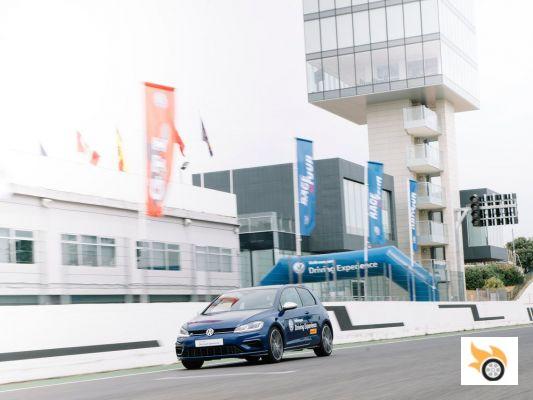
It makes more sense to have a second set of wheels, one with more versatile and effective water/snow repellent wheels, the other with semi-slick wheels to blow them up on the track. Whoever can spend more than 40.000 eypos on a compact won't suffer so much if on a track day they air a set of wheels that are made for that. The difference between a child and an adult is measured in the price of their toys. End of quote.

























